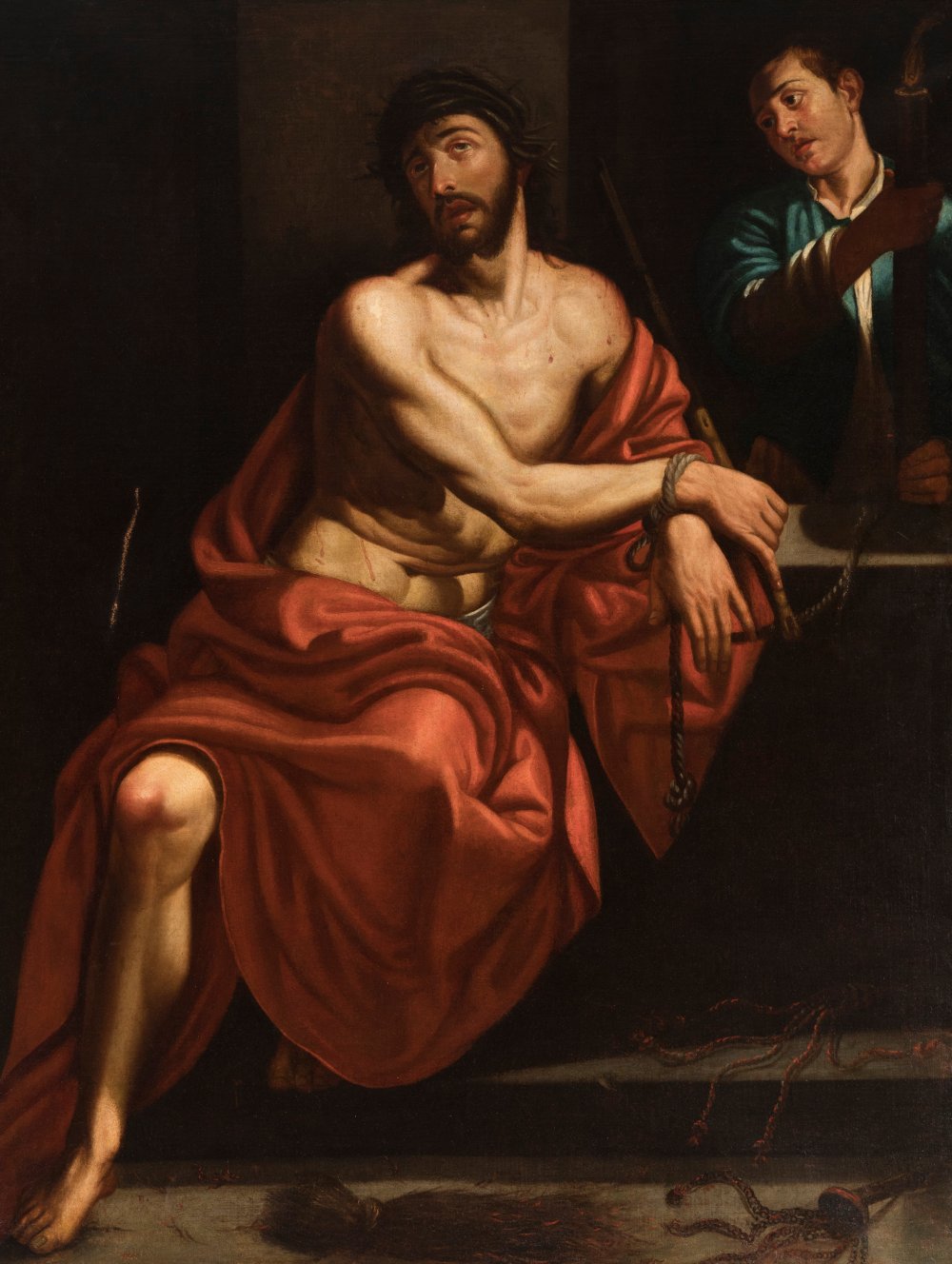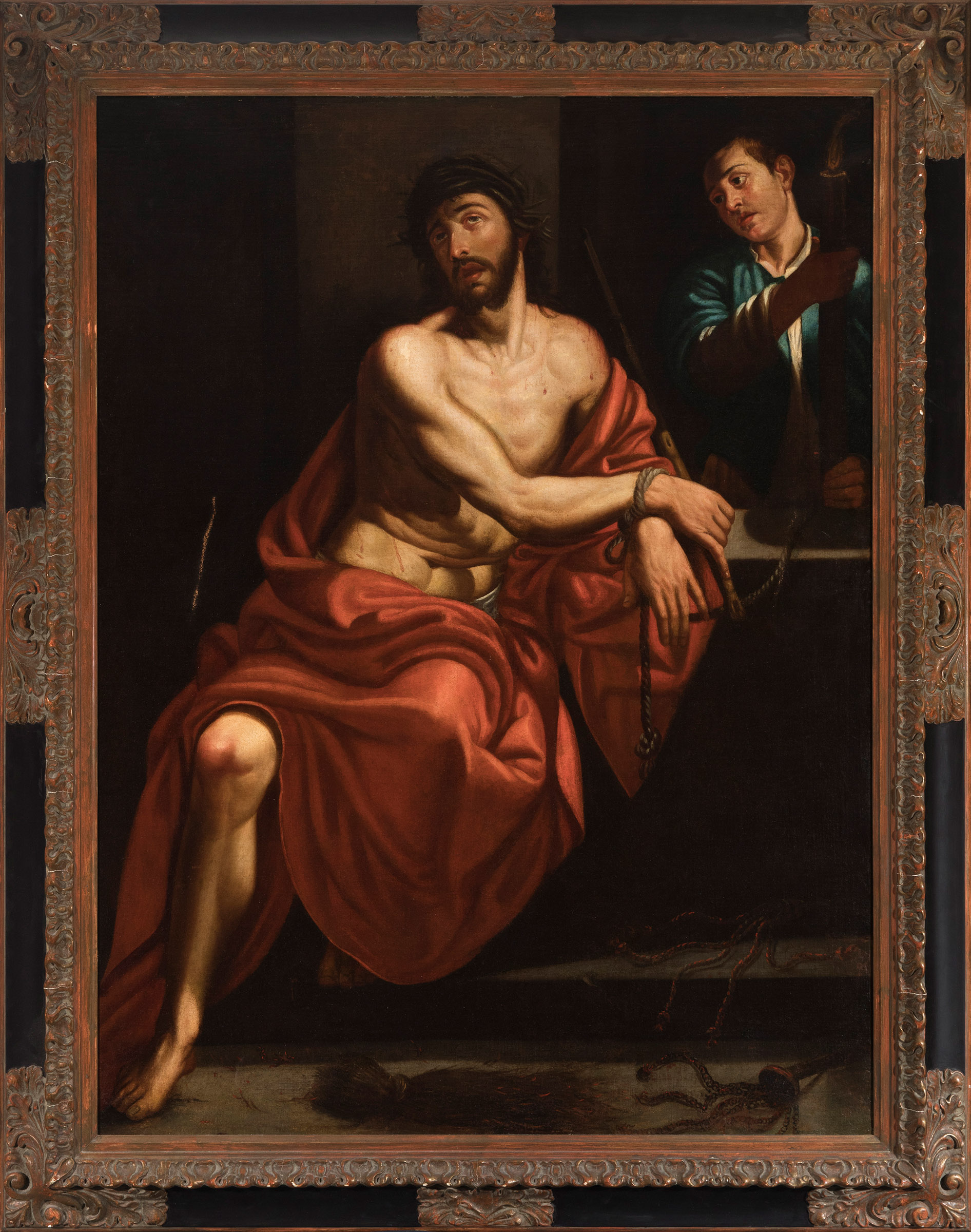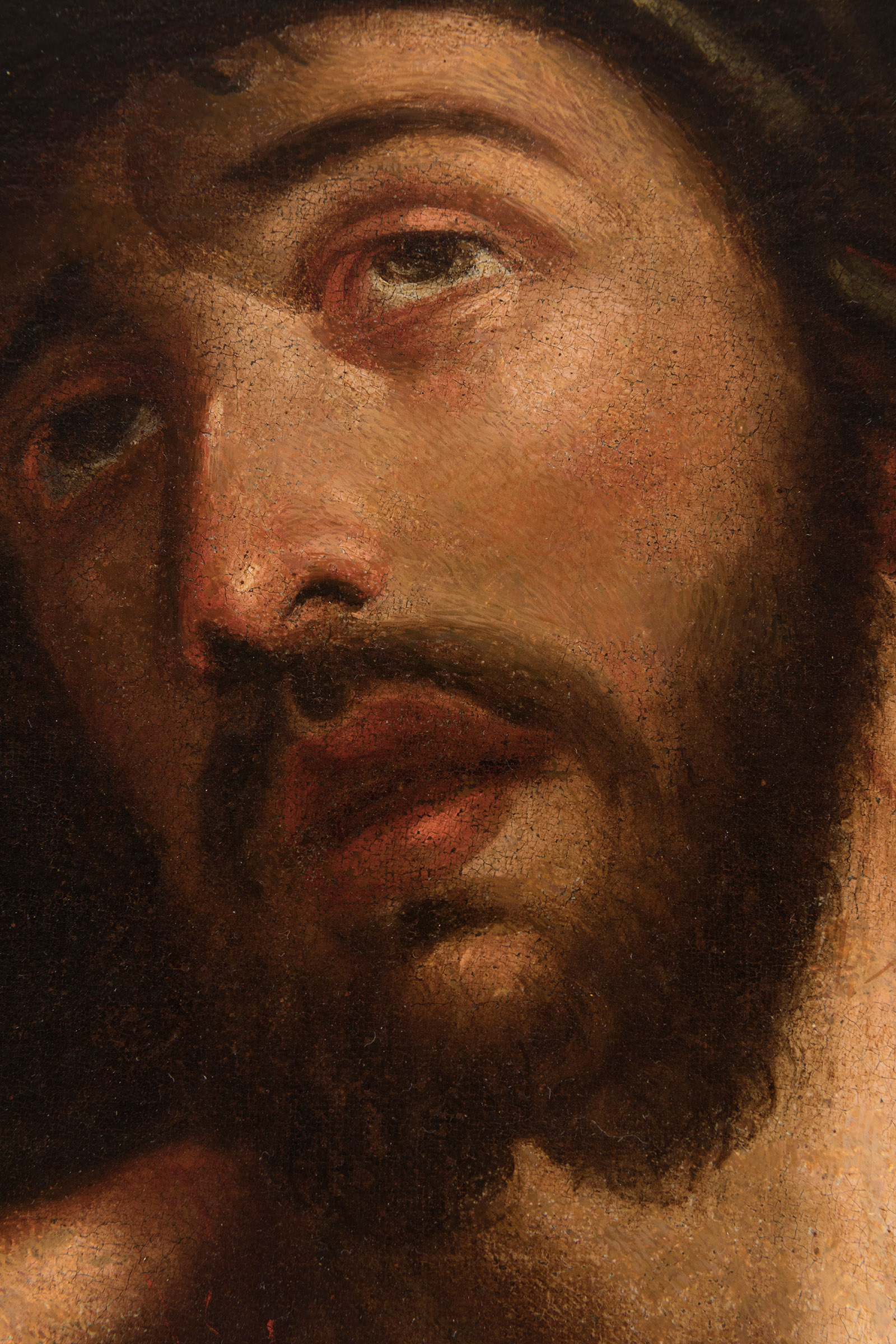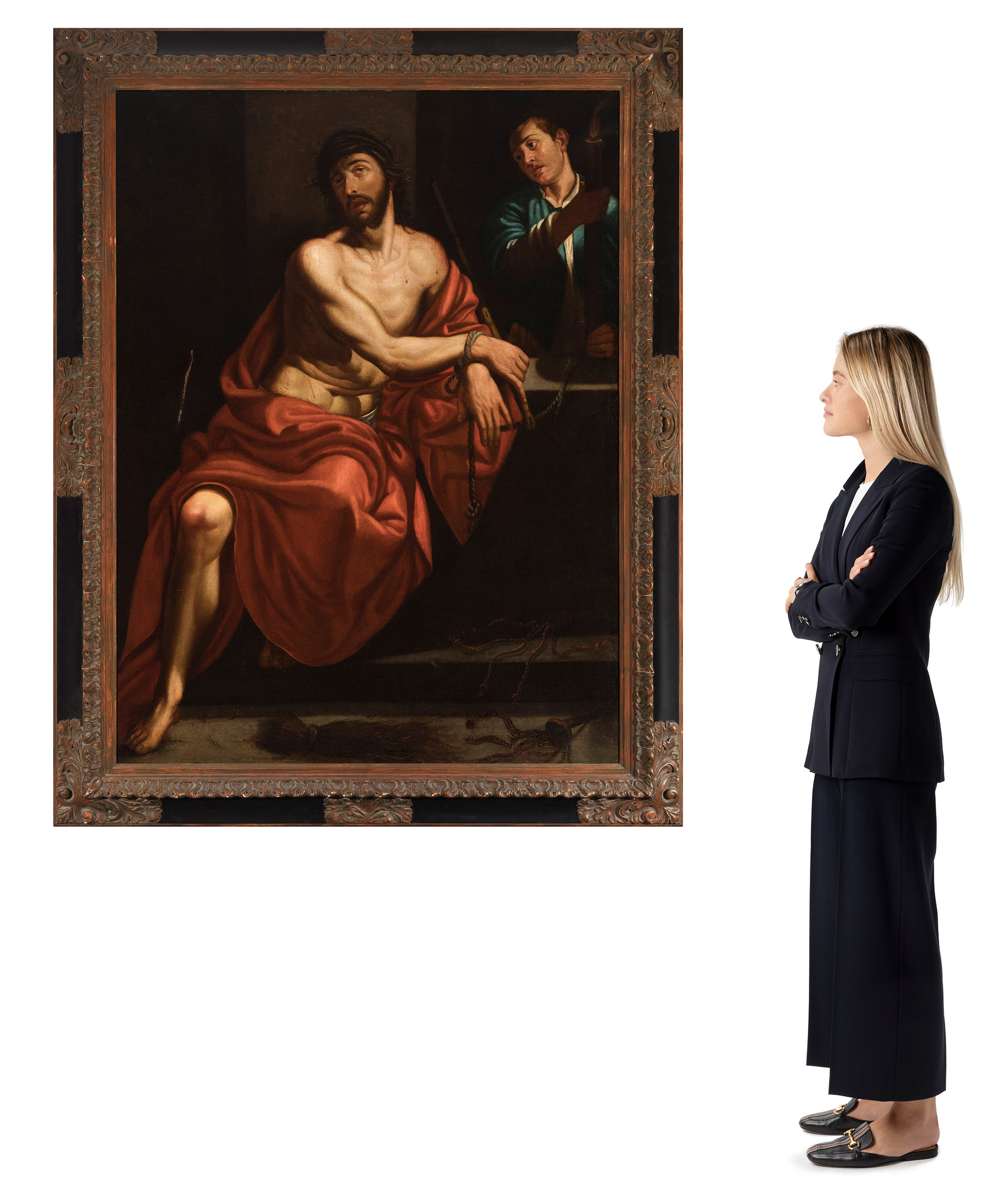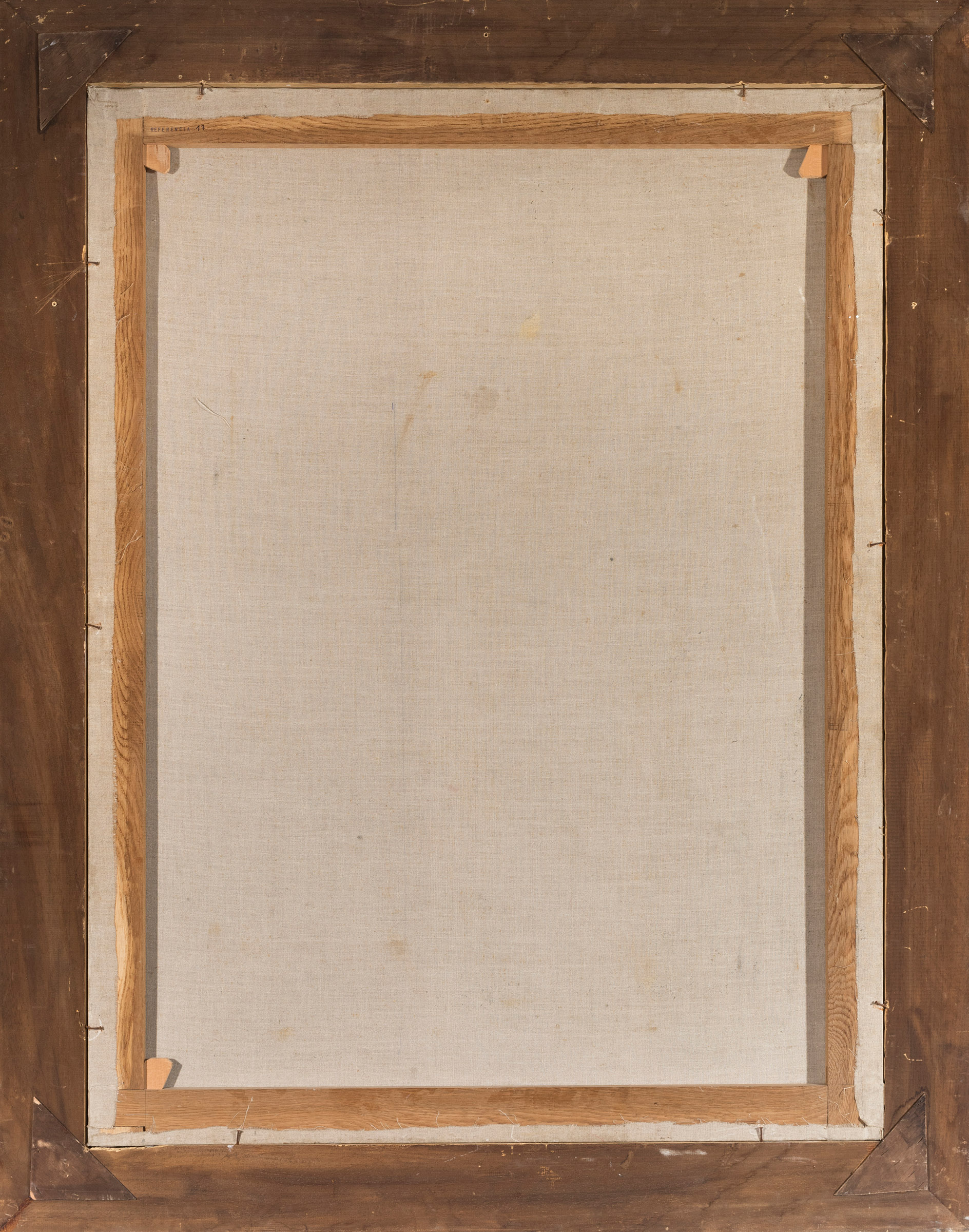42
Caravaggista school; 17th century."Ecce homo".Oil on canvas. Relined.It presents restorations and
"Ecce homo".
Oil on canvas. Relined.
It presents restorations and repainting.
Measurements: 133 x 100 cm; 159 x 125 cm (frame).
In this devotional canvas, probably painted for an altar or a private chapel, the theme of the Ecce Homo is represented, very common in this type of paintings. The simple, clear composition, with the body of Christ in the foreground, and the absence of narrative details adds to the expressive power and pathos, designed to move the soul of the faithful who pray before the image, within a sense of tremendism that is very typical of the Baroque period in Catholic countries. The theme of Ecce Homo belongs to the Passion cycle and precedes the episode of the Crucifixion. Following this iconography, Jesus is presented at the moment when the soldiers have crowned him with thorns, in addition to dressing him in a purple tunic (here red, the symbolic colour of the Passion) and placing a reed in his hand (which is not visible in the present composition), kneeling down and exclaiming "Hail, King of the Jews! The words "Ecce Homo" are those pronounced by Pilate when presenting Christ to the crowd; their translation is "behold the man", a phrase by which he mocks Jesus and implies that Christ's power was not such in comparison with that of the rulers who were judging him. The piece is completed by the presence of a character who contemplates Christ; this character is presented in a veiled manner, without taking away the prominence of the divine image.
Stylistically, the work shows a clear influence of Caravaggio and the followers of his style: the theatrical use of a powerful spotlight, the combination of this strong lighting with areas of darkness, the use of diagonals, the use of models inspired by the common people (although without the extraordinary realism of the Italian master in the present work due to a greater degree of idealisation of the faces), etc. Michelangelo Merisi da Caravaggio, known as Caravaggio, was an Italian painter active in Rome, Naples, Malta and Sicily between 1593 and 1610. His painting combines a realistic observation of the human figure, both physical and emotional, with a dramatic use of light, which had a decisive influence on the formation of Baroque painting. Caravaggio depicted close anatomical observation with a dramatic use of chiaroscuro that came to be known as tenebrism. This technique became a dominant stylistic element, darkening shadows and transfiguring objects into brilliant beams of light. He vividly expressed crucial moments and scenes, often involving violent struggle, torture and death. He worked quickly with models from life, dispensing with sketches to work directly on canvas. His influence was profound on the new Baroque style that emerged from Mannerism and can be traced in the works of great masters such as Pedro Pablo Rubens, José de Ribera, Rembrandt and Diego Velázquez, as well as in countless artists of the following generation, who because they manifested his profound influence were called "Caravaggists" or "Tenebrists".
"Ecce homo".
Oil on canvas. Relined.
It presents restorations and repainting.
Measurements: 133 x 100 cm; 159 x 125 cm (frame).
In this devotional canvas, probably painted for an altar or a private chapel, the theme of the Ecce Homo is represented, very common in this type of paintings. The simple, clear composition, with the body of Christ in the foreground, and the absence of narrative details adds to the expressive power and pathos, designed to move the soul of the faithful who pray before the image, within a sense of tremendism that is very typical of the Baroque period in Catholic countries. The theme of Ecce Homo belongs to the Passion cycle and precedes the episode of the Crucifixion. Following this iconography, Jesus is presented at the moment when the soldiers have crowned him with thorns, in addition to dressing him in a purple tunic (here red, the symbolic colour of the Passion) and placing a reed in his hand (which is not visible in the present composition), kneeling down and exclaiming "Hail, King of the Jews! The words "Ecce Homo" are those pronounced by Pilate when presenting Christ to the crowd; their translation is "behold the man", a phrase by which he mocks Jesus and implies that Christ's power was not such in comparison with that of the rulers who were judging him. The piece is completed by the presence of a character who contemplates Christ; this character is presented in a veiled manner, without taking away the prominence of the divine image.
Stylistically, the work shows a clear influence of Caravaggio and the followers of his style: the theatrical use of a powerful spotlight, the combination of this strong lighting with areas of darkness, the use of diagonals, the use of models inspired by the common people (although without the extraordinary realism of the Italian master in the present work due to a greater degree of idealisation of the faces), etc. Michelangelo Merisi da Caravaggio, known as Caravaggio, was an Italian painter active in Rome, Naples, Malta and Sicily between 1593 and 1610. His painting combines a realistic observation of the human figure, both physical and emotional, with a dramatic use of light, which had a decisive influence on the formation of Baroque painting. Caravaggio depicted close anatomical observation with a dramatic use of chiaroscuro that came to be known as tenebrism. This technique became a dominant stylistic element, darkening shadows and transfiguring objects into brilliant beams of light. He vividly expressed crucial moments and scenes, often involving violent struggle, torture and death. He worked quickly with models from life, dispensing with sketches to work directly on canvas. His influence was profound on the new Baroque style that emerged from Mannerism and can be traced in the works of great masters such as Pedro Pablo Rubens, José de Ribera, Rembrandt and Diego Velázquez, as well as in countless artists of the following generation, who because they manifested his profound influence were called "Caravaggists" or "Tenebrists".
9th November - Old Masters
Sale Date(s)
Venue Address
General delivery information available from the auctioneer
Setdart offers Worldwide shipping
PICK UP IN ROOM: You can come and pick up your lots in our offices (Barcelona, Madrid or Valencia). At the moment of the withdrawal, you will be able to accept the current conditions of the lot by means of a document that you will sign.
YOU CAN SEND ANOTHER PERSON TO PICK UP: This person must present a signed authorization that you can find in our web page by accessing from BUY AT SETDART- LOGISTICS-DOWNLOAD AUTHORIZATION DOCUMENT. You can also send an e-mail with the requested data in AUTHORIZATION DOCUMENT to admin@setdart.com
Important Information
25% buyer´s premium
OR
21% buyer´s premium at www.setdart.com
Terms & Conditions
The maximum period to pay the lots is 7 working days. You can pay either via bank transfer or with credit card through our platform www.setdart.com (we only accept VISA or Mastercard).
BUYER´S PREMIUM: 22% Hammer price + 21% VAT from the buyer´s premium
If your piece has more than 100 years, our Ministry of Culture requires an export certificate in order for the piece to leave the country. Note that if the piece goes inside the EU, there is no cost for the export certificate. If the piece goes outside the EU, there is a cost for the export certificate. You can find more information in our Ministry of Culture website: https://www.culturaydeporte.gob.es/en/cultura/patrimonio/exportacionimportacion/exportacion/tasas.html
INQUIRIES: admin@setdart.com
Setdart guides you through the entire process, from the time of award to the day you receive your lot. Our logistics team will be happy to manage your transport, and will advise you on the best shipping method with professionals from the sector used to handling works of art and jewelry.
WE OFFER WORLDWIDE DOOR TO DOOR SHIPPING
PICK UP IN ROOM: You can come and pick up your lots in our offices. At the moment of the withdrawal, you will be able to accept the current conditions of the lot by means of a document that you will sign.
YOU CAN SEND ANOTHER PERSON TO PICK UP: This person must present a signed authorization that you can find in our web page by accessing from BUY AT SETDART-LOGISTICS-DOWNLOAD AUTHORIZATION DOCUMENT. You can also send an e-mail with the requested data in AUTHORIZATION DOCUMENT to admin@setdart.com
SETDART IS NOT RESPONSIBLE FOR THE STATE OF THE PARTS ONCE THEY LEAVE OUR FACILITIES. MRW SHIPMENTS: Once the payment is made, your lot will be packed for shipment, the logistics department will send you an e-mail notifying you of the day it leaves our warehouse, changes of address cannot be made after receiving this e-mail.
INSURANCE INCIDENTS: Coverage for the value of the auction up to 3000 ? per shipment, if the value of the auction is higher, Setdart will send you a quote including the additional insurance. The insurance company WILL NOT BE RESPONSIBLE FOR THE SHIPMENT THAT EXCEEDS THAT AMOUNT AND IS NOT FULLY INSURED. MRW INCIDENTS: Maximum notification 48 hours after receipt, after which the insurance company WILL NOT BE RESPONSIBLE AND NO CLAIMS WILL BE ACCEPTED.
E-MAIL LOGISTICS: logistica@setdart.com
PICK UP YOUR MESSAGES: You can send your own messaging, prior notice via e-mail that your shipment is ready, please note 3 or 4 days in advance. This type of shipment is packaged so Setdart will provide you with a quote.
EXPENSES FOR STORAGE: We inform you that if the purchased lot is not picked up within a month, you will be charged 30€ per week per lot. Setdart Online S.L., owner of the web site "setdart.com", "setdart.net" and "setdart.org", acts as a company of Spanish nationality inscribed in the Volume 36955, sheet 182, page B-293056 of the Mercantile Registry, with registered office at Calle Aragó











